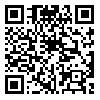Volume 20, Issue 2 (Summer 2025)
Salmand: Iranian Journal of Ageing 2025, 20(2): 226-241 |
Back to browse issues page
Download citation:
BibTeX | RIS | EndNote | Medlars | ProCite | Reference Manager | RefWorks
Send citation to:



BibTeX | RIS | EndNote | Medlars | ProCite | Reference Manager | RefWorks
Send citation to:
Esmaeili H, Abolfathi Momtaz Y, Haghi M, Foroughan M. The Doctor-Patient Relationship Status and the Associated Factors in Older Adults from Tehran, Iran. Salmand: Iranian Journal of Ageing 2025; 20 (2) :226-241
URL: http://salmandj.uswr.ac.ir/article-1-2826-en.html
URL: http://salmandj.uswr.ac.ir/article-1-2826-en.html
1- Department of Gerontology, Iranian Research Center on Aging, University of Social Welfare and Rehabilitation Sciences, Tehran, Iran.
2- Department of Gerontology, Iranian Research Center on Aging, University of Social Welfare and Rehabilitation Sciences, Tehran, Iran. ,yabolfathi@gmail.com
2- Department of Gerontology, Iranian Research Center on Aging, University of Social Welfare and Rehabilitation Sciences, Tehran, Iran. ,
Abstract: (2268 Views)
Objectives Studies have shown that the doctor-patient relationship has a significant impact on the health and adherence to treatment in older adults. However, there are inconsistencies between different studies regarding the associated factors. Therefore, this study aims to determine the doctor-patient relationship status and the associated factors from the perspective of older adults in Tehran, Iran.
Methods & Materials This a descriptive-analytical study with a cross-sectional design conducted in 2023. A total of 382 people aged 60 or higher were selected by a multi-stage cluster random sampling method from among those referred to clinics in Tehran. In order to collect data, a sociodemographic checklist and the doctor-patient communication (DPC) scale were used. The collected data were analyzed in SPSS software, version 26.
Results The mean age of participants was 69.79±6.86 years, and about 66% of them were women. Most participants (88.2%) perceived their relationship with their doctor as good. There was a significant difference the doctor-elderly patient relationship based on educational level (P=0.032), autoimmune diseases (P=0.001) and other uncommon diseases in old age (P=0.043), gender of doctors (P=0.016), specialty of doctors (P=0.002), acceptance of insurance as one of criteria for choosing a doctor (P=0.012), duration of being under the doctor’s supervision (P=0.011) and duration of visit (P=0.001). The results of multiple linear regression analysis showed that the doctor-patient relationship variable was significantly predicted by the patients’ educational level, recommendation of another doctor for choosing a doctor, and duration of visit.
Conclusion Most of elderly patients in Tehran have a good relationship with their doctor. It is recommended to consider the elderly patient’s educational level, the recommendation of another doctor, and the duration of the doctor’s visit to improve the doctor-elderly patient relationship.
Methods & Materials This a descriptive-analytical study with a cross-sectional design conducted in 2023. A total of 382 people aged 60 or higher were selected by a multi-stage cluster random sampling method from among those referred to clinics in Tehran. In order to collect data, a sociodemographic checklist and the doctor-patient communication (DPC) scale were used. The collected data were analyzed in SPSS software, version 26.
Results The mean age of participants was 69.79±6.86 years, and about 66% of them were women. Most participants (88.2%) perceived their relationship with their doctor as good. There was a significant difference the doctor-elderly patient relationship based on educational level (P=0.032), autoimmune diseases (P=0.001) and other uncommon diseases in old age (P=0.043), gender of doctors (P=0.016), specialty of doctors (P=0.002), acceptance of insurance as one of criteria for choosing a doctor (P=0.012), duration of being under the doctor’s supervision (P=0.011) and duration of visit (P=0.001). The results of multiple linear regression analysis showed that the doctor-patient relationship variable was significantly predicted by the patients’ educational level, recommendation of another doctor for choosing a doctor, and duration of visit.
Conclusion Most of elderly patients in Tehran have a good relationship with their doctor. It is recommended to consider the elderly patient’s educational level, the recommendation of another doctor, and the duration of the doctor’s visit to improve the doctor-elderly patient relationship.
Type of Study: Research |
Subject:
gerontology
Received: 2024/04/05 | Accepted: 2024/07/29 | Published: 2025/07/01
Received: 2024/04/05 | Accepted: 2024/07/29 | Published: 2025/07/01
Send email to the article author
| Rights and permissions | |
 |
This work is licensed under a Creative Commons Attribution-NonCommercial 4.0 International License. |








